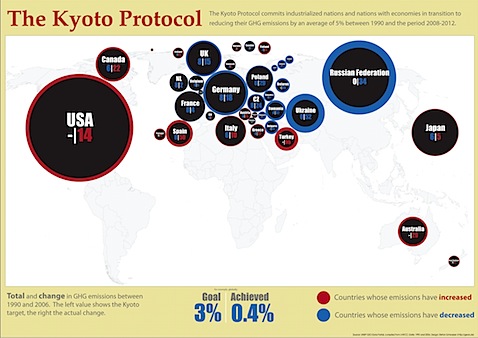| Emissions Trading |
|
|
| Kyoto Protocol |
The Kyoto Protocol treaty was negotiated in December 1997 at the city of Kyoto, Japan and came into force February 16th, 2005. "The Kyoto Protocol is a legally binding agreement under which industrialized countries will reduce their collective emissions of greenhouse gases by 5.2% compared to the year 1990 (but note that, compared to the emissions levels that would be expected by 2010 without the Protocol, this target represents a 29% cut). The goal is to lower overall emissions from six greenhouse gases - carbon dioxide, methane, nitrous oxide, sulfur hexafluoride, HFCs, and PFCs - calculated as an average over the five-year period of 2008-12. National targets range from 8% reductions for the European Union and some others to 7% for the US, 6% for Japan, 0% for Russia, and permitted increases of 8% for Australia and 10% for Iceland." |
| India Emission Trading Scheme |
| India is the third largest emitter of Green House Gas (GHG) in the world, next only to China and USA. Unlike the US that lacks a national emission trading scheme, both India and China have established their nationwide emission trading scheme to help curb the menace of climate change through mandatory GHG emission reduction. On July 2010, India formally announced its market-based carbon trading scheme called Perform, Achieve and Trade (PAT). This scheme was implemented on April 1, 2011 and will continue through to 2014. Through PAT, the government has set mandatory targets for 563 facilities, which include power plants, which account for 54 per cent of India’s energy use. Businesses that need more energy can buy certificates, known as Escerts, from those that use less. This trading scheme will help India reduce carbon emissions by 100 million tons a year, according to government estimates, and save about 19 gigawatts of energy. Apart from PAT, India also has a Renewable Energy Certificate (REC) trading scheme for wind, solar and Biomass power plants. While coal is still the major source of energy for the fast growing economy, renewable sources of energy have climbed up the ladder to stand at 8 per cent of the total power generation. The REC trading happens once a month. On May 25, 14,000 RECs were traded on the Indian Energy Exchange, with a $4.6 value, while in April only 260 units were traded. Through the REC trading scheme amongst others, the government hopes to be able to generate 72.4 gigawatts of renewable energy, out of which 20 gigawatts would be from solar power, by 2022. |
| BMC Is The First To Get India Tech Excellence Award |
| The BMC has received India Tech Excellence award for closing its 19.6 hectare Gorai dumping ground in a scientific manner. BMC is the first civic body in country that has encased carbon credit reducing greenhouse gas emission and earned Rs24.50 crore. India Tech Excellence award is given by the central government for innovative work in urban development sector. The award was given by President Pratibha Patil. “We are really happy that our work has been endorsed by this prestigious award. We feel very proud. BMC is first civic body that has earned Rs24.50 crore by tapping methane before it goes in to the environment. We have to keep doing it for at least ten years. We are hoping to earn almost Rs80 crore from this entire process,” said Bhalchandra Patil, chief engineer of BMC’s solid waste management. BMC expects to earn Rs 72 crore from carbon credits by 2015 The BMC received its first cheque of Rs 24, 51, 39, 862 in September 2009 from Asian Development Bank (ADB), with whom the administration has signed an Emission Reduction Purchase Agreement in 2008, where in the Certified Emission Reductions (CERs) or carbon credits generated at the Gorai dump would be sold to. |
| |
The Intergovernmental Panel on Climate Change (IPCC) is the leading international body for the assessment of climate change. It was established by the United Nations Environment Programme (UNEP) and the World Meteorological Organization (WMO) to provide the world with a clear scientific view on the current state of knowledge in climate change and its potential environmental and socio-economic impacts. The UN General Assembly endorsed the action by WMO and UNEP in jointly establishing the IPCC. |


